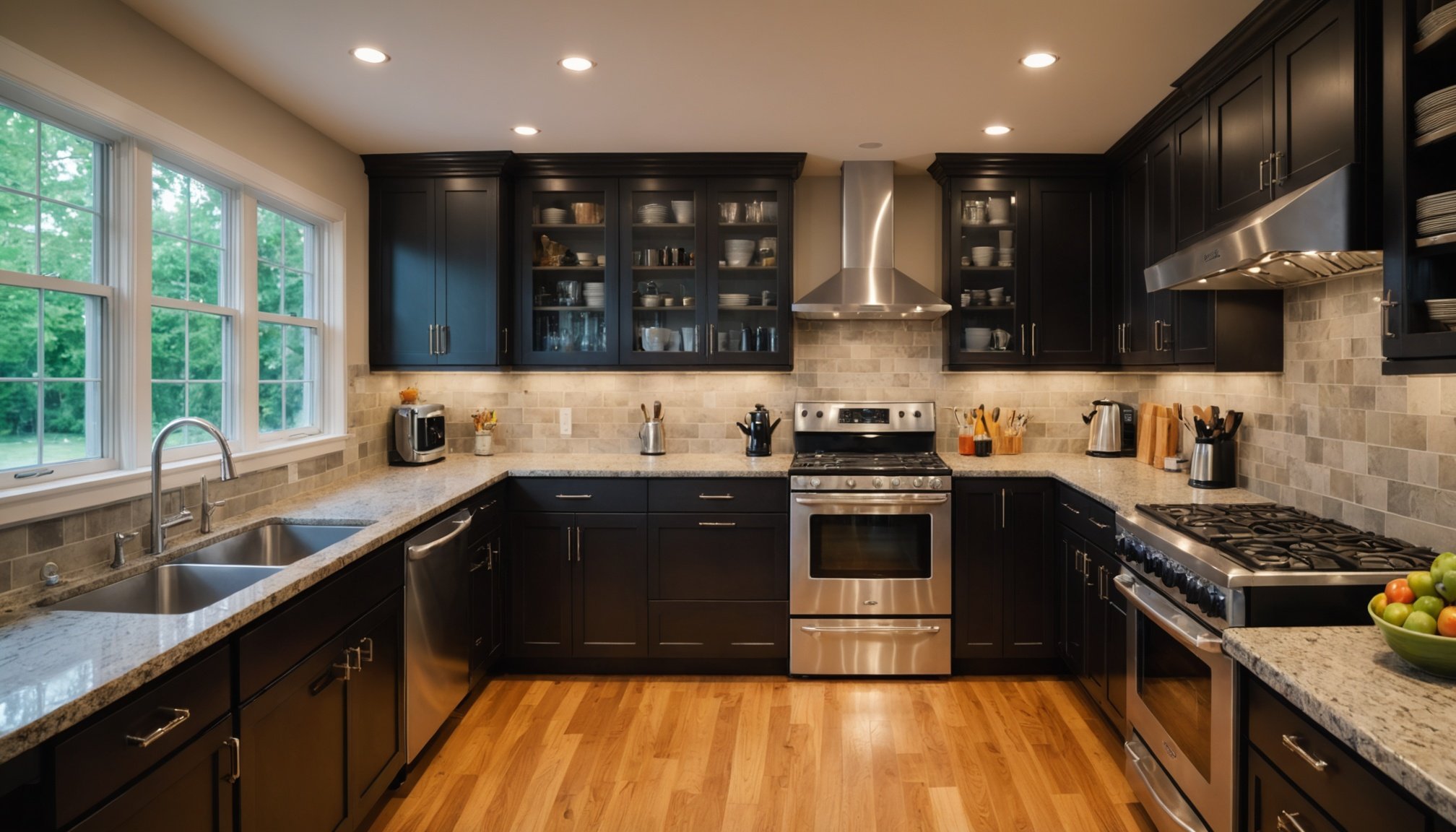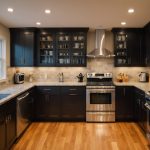Smart Kitchen Layout: How Strategically Placing Your Main Work Area Can Curb Overeating
When it comes to maintaining a healthy lifestyle, the kitchen often serves as the heart of the home, where meals are prepared and eating habits are formed. However, the layout of your kitchen can significantly impact your eating habits, particularly in terms of overeating. Here’s how a smart kitchen layout can help you make healthier choices and control your food intake.
Understanding the Psychology of Eating
Before we dive into the specifics of kitchen layout, it's essential to understand the psychological aspects of eating. Overeating can be triggered by various factors, including emotional eating, lack of portion control, and unhealthy food choices.
Also to see : Optimal Kitchen Seating Solutions for Promoting Mindful Eating Practices
Emotional Eating
Emotional eating is a common issue where people use food as a way to cope with stress, boredom, or other emotions. This can lead to consuming more calories than needed, often in the form of unhealthy snacks or large portions.
Portion Control
Portion control is another critical aspect of healthy eating. Many people underestimate the calories they consume, especially when eating out or at fast food restaurants. Keeping track of portion sizes can help in maintaining a balanced diet.
Also to see : Transform Your Slim Diet: The Benefits of a Meal Planning Whiteboard in Your Kitchen
Designing Your Kitchen for Healthy Eating
The layout of your kitchen can play a significant role in promoting healthier eating habits. Here are some strategies to consider:
Optimize Your Workspace
The main work area in your kitchen should be designed to encourage mindful eating and healthy food preparation. Here are a few tips:
- Centralize Your Workspace: Ensure that your main work area is centrally located, making it easy to access all necessary utensils, ingredients, and appliances. This can help in reducing the temptation to grab quick, unhealthy snacks.
- Use Vertical Space: Utilize wall-mounted shelves and cabinets to keep healthy ingredients and snacks visible and easily accessible. This can encourage you to choose fruits and vegetables over processed foods.
- Invest in a Large Cutting Board: A large cutting board can help in preparing meals that include a variety of vegetables and fruits, promoting healthier meal planning.
Create a Mindful Eating Environment
The environment in which you eat can significantly influence your eating habits. Here’s how to create a mindful eating environment in your kitchen:
- Dedicate a Dining Area: Having a dedicated dining area can help you distinguish between eating and other activities. This can reduce the likelihood of eating in front of the TV or while browsing your phone.
- Use Proper Lighting: Soft, warm lighting can create a comfortable and inviting atmosphere, encouraging you to enjoy your meals more mindfully.
- Minimize Distractions: Keep the dining area free from distractions like TVs, phones, and other electronic devices to promote mindful eating.
Practical Strategies for Healthy Eating
Here are some practical strategies that can be integrated into your kitchen layout to promote healthier eating habits:
Meal Planning
Meal planning is a powerful tool for maintaining healthy eating habits. Here’s how you can incorporate meal planning into your kitchen layout:
- Meal Planning Board: Install a meal planning board or a chalkboard in your kitchen where you can plan your meals for the week. This can help in ensuring that you prepare healthy meals and avoid last-minute, unhealthy choices.
- Grocery List: Keep a grocery list near your meal planning board to ensure that you buy only the ingredients needed for your planned meals.
Portion Control
Portion control is crucial for maintaining a healthy diet. Here are some tips to help you control portion sizes in your kitchen:
- Use Smaller Plates: Using smaller plates can help in reducing the amount of food you serve yourself. This visual cue can make your meals appear more filling.
- Measure Your Portions: Keep measuring cups and spoons handy to measure out your portions accurately.
Healthy Snacking
Healthy snacking is essential for maintaining a balanced diet. Here’s how you can encourage healthy snacking in your kitchen:
- Snack Station: Create a snack station with healthy options like fruits, nuts, and vegetables. This can be a designated area on your counter or a specific shelf in your pantry.
- Pre-Prepared Snacks: Prepare healthy snacks in advance, such as cutting fruits and vegetables, to make them easily accessible.
Example of a Smart Kitchen Layout
Here’s an example of how you can design a smart kitchen layout to promote healthy eating habits:
Layout Example
| Area | Description | Tips for Healthy Eating |
|---|---|---|
| Central Workspace | Central island or countertop with easy access to utensils, ingredients, and appliances. | Keep healthy ingredients visible and accessible. Use a large cutting board for meal preparation. |
| Dining Area | Dedicated dining table and chairs. | Soft lighting, minimal distractions, and comfortable seating. |
| Meal Planning Board | Chalkboard or whiteboard near the central workspace. | Plan meals for the week, keep a grocery list handy. |
| Snack Station | Designated area on the counter or a shelf in the pantry. | Pre-prepared healthy snacks like fruits and vegetables. |
| Pantry | Organized pantry with healthy ingredients at eye level. | Use vertical space to keep healthy snacks visible. |
Quotes and Insights from Experts
- "The key to healthy eating is not just about the food you eat, but also the environment in which you eat it. A well-designed kitchen can encourage mindful eating and healthier food choices," says a nutrition expert.
- "Portion control is often underestimated. Using smaller plates and measuring cups can make a significant difference in the amount of food you consume," advises a dietitian.
Overcoming Common Challenges
Managing Emotional Eating
Emotional eating can be a significant challenge, but there are strategies to overcome it:
- Stay Hydrated: Sometimes, thirst can be mistaken for hunger. Keeping a water bottle in the kitchen can remind you to stay hydrated.
- Engage in Activities: If you find yourself eating out of boredom, engage in other activities like reading, gardening, or even light exercise.
- Seek Support: If emotional eating is a persistent issue, consider seeking help from a cognitive behavioral therapist or a nutrition counselor.
Maintaining Healthy Habits Over Time
Maintaining healthy eating habits over time requires consistency and planning. Here are some tips to help you stay on track:
- Make It a Routine: Incorporate healthy eating into your daily routine, just like brushing your teeth or taking a shower.
- Involve Family and Friends: Cooking and eating with family and friends can make the experience more enjoyable and help you stay committed to your healthy eating plan.
- Celebrate Small Wins: Celebrate small victories, like completing a week of healthy meal planning, to keep yourself motivated.
Designing a smart kitchen layout is more than just about aesthetics; it's about creating an environment that promotes healthy eating habits. By optimizing your workspace, creating a mindful eating environment, and incorporating practical strategies for meal planning and portion control, you can significantly reduce the likelihood of overeating.
Remember, healthy eating is a journey, and it starts with small changes in your daily habits. By making these changes, you can set yourself on the path to a healthier, happier you.
Final Tips
- Start Small: Begin with small changes, like rearranging your pantry or using smaller plates.
- Be Consistent: Consistency is key. Stick to your healthy eating plan even on weekends and holidays.
- Seek Help When Needed: If you find it challenging to maintain healthy eating habits, don’t hesitate to seek help from a nutrition expert or a therapist.
By following these tips and designing a smart kitchen layout, you can make healthier choices and enjoy a more balanced diet, ultimately leading to better health and well-being.











